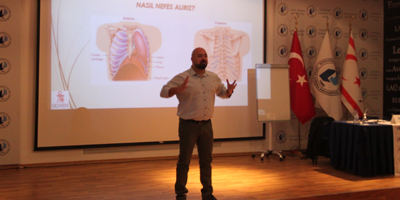Surgeon Dr. Çetinkanat Discussed “Thorax Traumas and Thoracic Surgery Emergencies” at EUL

Surgeon Dr. Çetinkanat shared his experiences on chest injuries
Assoc. Prof. Dr Cihan Genco Çetinkanat attended “Thorax Traumas and Thoracic Surgery Emergencies” themed conference which was organized by the European University of Lefke (EUL) Vocational Healthcare Academy as a speaker.
Providing comprehensive information about thoracic trauma and thoracic surgery, Çetinkanat began his speech by explaining why thoracic traumas are important. During his speech Cetinkanat stated that in the United States, in every 12 minutes one person loses their life, in every 10 seconds one person gets injured and in every 5 seconds an accident occurs.
Cetinkanat mentioned the methods of chest injuries that occur in a crash, and said that “The methods of these types of chest injuries are 2-staged, these stages are primary trauma and possible secondary trauma, and if the wound is 1st and 2nd rib fractures in the primary trauma, subclavian artery, vena cava superior, aortic puncture, trachyabronchial ruptures can occur in case of possible skender trauma and results with 50% deaths in the primary trauma. Possible skater trauma in the 3rd and 8th rib fractures in primary trauma is very common and causes pulmonary injuries, pneumothorax and hemothorax.”
In his speech Çetinkanat touched upon what to do when confronted with a patient who has an accident, and he said that first of all general conviction, the patient’s level of consciousness should be checked and the patient should be scanned. He also added that while doing the scan one should look at the visible wounds, blood and blood stains, whether there is a breathing difficulty and whether there is irregular breathing.
Çetinkanat said that while controlling the upper airway and respiration system of the injured one should check; if the respiratory tract of the injured is open, early neck stabilization, jugular venous surveillance, whether the wound is breathing, whether the breathing is sufficient, and they should properly close the open wounds, and support the breathing.
